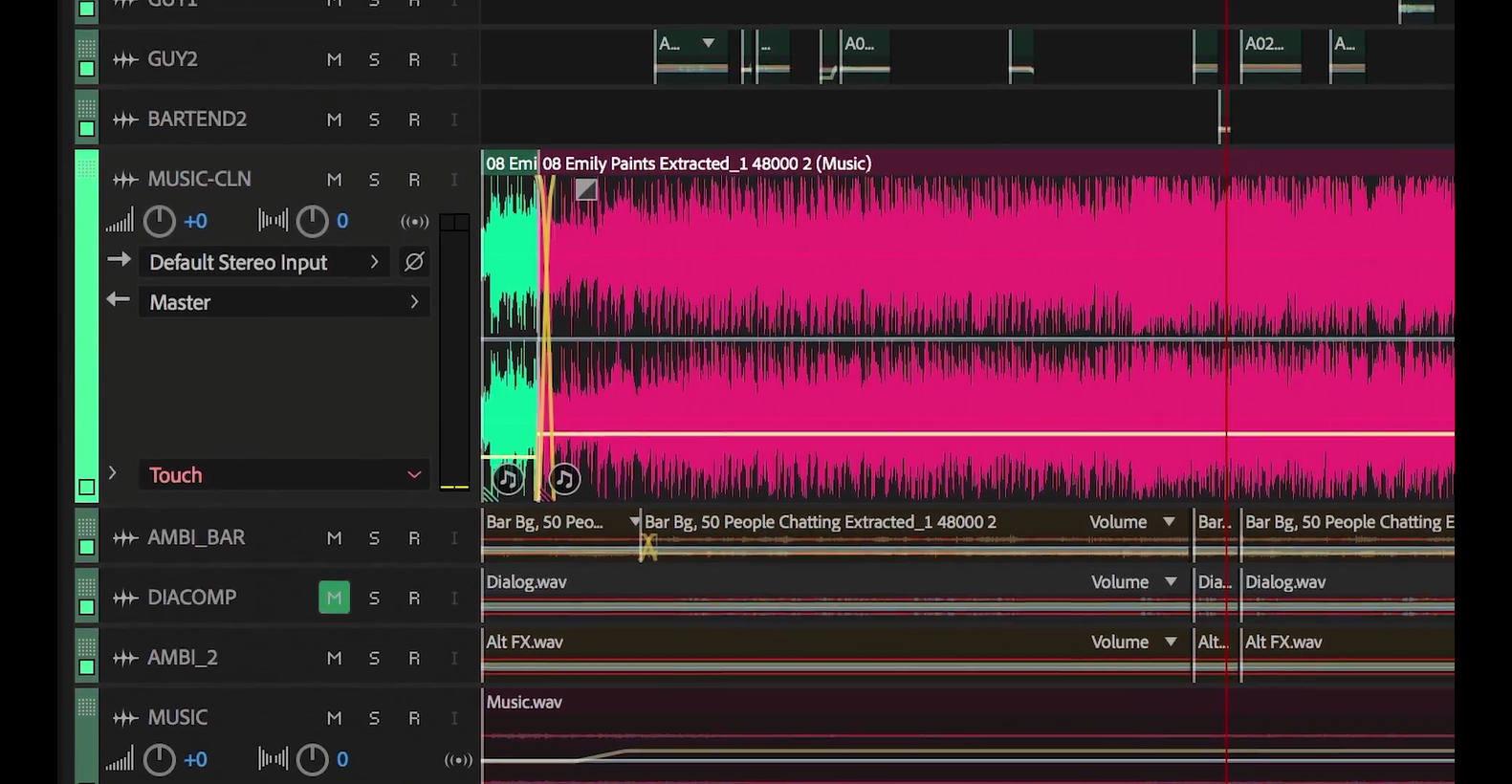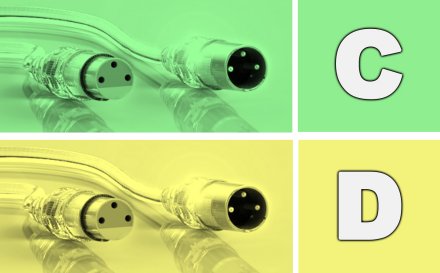
Virtual Audio Cable (VAC) is an audio bridge between applications that transmits sounds (audio streams) from app to app, from device to device.
Adobe Audition v.3 Record, mix, edit, and master digital audio files with powerful tools that bring flexibility and control to your desktop studio. Easily create music, produce radio spots, and restore imperfect recordings. Bring audio and video together using smart. This is how I have Audition set up with VB-CABLE: As long as your mic is the input and the virtual playback device is your output, you should be able to select associated the virtual recording device as your mic in OBS and have everything pop out fine. Be sure to arm for record and monitor input in Audition. Hi there I am having some trouble with VB virtual audio cable, I use adobe audition to process my microphone in real time to remove background noise and some other things. I then set the output to the input of the virtual audio cable and use the output from that as my microphone input for all my programs. Yesterday I got Virtual Audio Cable to work, then installed a SSD. When putting things back together, trying to put the VAC as an Output wasn't an answer. VB-Audio Input selection is in the Output. When I go to Audio Hardware, I have my mic in Input, but for the Output, it's the VB0Audio Virtual Cable Input.
VAC creates a set of virtual audio devices. Each device simulates an audio adapter (card) whose output is internally connected to the input, making a loopback. If an application plays audio to the output, the sound will not be audible because the signal is looped back to the input. But if another application records from the input, it receives the sound produced by the first app.
Such virtual devices are named Virtual Cables. The 'Virtual Cable' term is used only in VAC description, as a placeholder. Actual device/endpoint names that you will see in applications' windows, are different (for example, 'Line 1', 'Line 2' etc.).
Each side of any Virtual Cable can be used by several apps at the same time. Sounds directed to the same playback endpoint are mixed. From the recording endpoint, each app gets its own copy of the sound.
VAC delivers audio signals completely inside the computer. No audio hardware is required. There is no quality loss (if no format conversion and/or volume control are involved). If all required conditions are met, audio transfer is bitperfect, suitable for audiophile applications. In well-tuned systems, signal latency is very low.
To transfer/route audio signals from an endpoint (device) to another, VAC offers Audio Repeater application.
Warning: in the Internet, there are several other products using the 'Virtual Audio Cable' name. Some of them just use this name for promotional purposes, but some others are completely fake and contain malware. If you decide to try them, don't forget to check their sites/binaries with anti-malware software/services.
Applicability
Use VAC with the following audio applications and application classes:
- Internet Telephony/VoIP/SIP/voice messengers (Skype, Discord, Ventrilo, MicroSIP).
- Live mixing/DJ (vMix, Mixxx, VirtualDJ, VoiceMeeter Banana/Potato).
- Live broadcasting (Open Broadcaster/OBS Studio, WireCast, VidBlasterX. SAM Broadcaster).
- Speech synthesis/recognition (Google Text-to-Speech/Speech-to-Text, Dragon Naturally Speaking).
- Software synthesizers and studio/DAW (Ableton, Acid, AudioMulch, Band-in-a-Box, Bidule, Cakewalk/Sonar, Cubase, FL Studio, GarageBand, Logic, MiniMoog, n-Track, Nuendo, Reaktor, REAPER, Reason, Samplitude, Traktor, Vegas).
- Audio editors/recorders (Audacity, Adobe Audition, GoldWave, WaveLab, Sound Forge).
- Virtual Machines (VMware Player/Workstation, VirtualBox, Hyper-V).
- Amateur and software-defined radio (Flex Radio, PowerSDR, HAM Radio Deluxe, HamSphere, HDSDR, Fldigi, SDR-Radio, WSJT-X, JTDX).
- Audio application development - watch the application's audio operations, check audio data played, supply with specific data to be recorded etc.
Compatibility
VAC works in Windows XP, Vista, 7, 8, 8.1 and 10.
No obsessive activity
VAC just performs things what it is intended for: passes audio streams between applications, converting audio formats if necessary. It never guides you to advertising pages, nor pops up busily on the screen, nor installs hidden activities in your system. VAC does only actions that you explicitly demand for.
Older versions
VAC 4 works only under Windows versions starting from XP (5.1). For support of older Windows releases, please visit VAC 3 page.
Noise reduction & restoration
De noise:
simple just move the slider to 0-100% to reduce amount of sound.
Enable output Noise only: listen only the noise level useful to cut the noise.
Then apply gain to get actual value from reduced lower sound.
Pros: simple just like noise reduction technique in other softwares like audacity.
Adaptive noise reduction: (more parameters)
standard noise reduction only for post processing, not for live processing, so adaptive noise reduction must for live podacasts or streaming games.
Note: it’s realtime processing so need little bit extra cpu power otherwise delay due to heavy processing.
Reduce Noise By: 6-30db better, 20db by default,
Just it substract the noise. (you can monitor it while adjusting)
Noiseness: it’s indicates amount of noise in original audio.(so we can reduce accordingly)
Fine tune noise floor: manually adjusting it above or below the automatically calculated noise floor.
Signal threshold: manually adjusting desried audio level above or below the automatically calculated threshold.
Special decay rate: how quickly drops to 60db
Baseband preservation:
Saving frequency of vocals helps to boost audio quality. (Need to know about equalization)
FFT SIZE: length of frequency band. Or how many individual frequency bands are analyzed.
Processing focus:
High frequency focus
Mid frequency focus
Techniques for restoring audio
Sound Remover effect
Automatic Click Remover effect
Click/Pop Eliminator effect
DeReverb effect
Hiss Reduction effect (Waveform Editor only)
Fliter and Equalizer
FFT Filter Effect:
Fast Fourier Transform an algorithm quickly analyzes frequency and amplitude of sound wave.
High pass filter(HP): Passes the high frequency and cuts the lower frequencies.
Low pass filter(LP): passes the lower frequency and cuts the higher frequencies.
Narrow band pass filter/ telephony : 350-4000hz here only the vocals of human to avoid background noise. Telephone uses this spectrum.

Notch filter: to remove precise frequency low 60hz, monitor it just up& down , find a noise in a specific range, then use notch filter and drag drop to remove entire sound.
Tradeoff between frequency and time accuracy.
Lower reduced transient artifacts
Parametric Equalizer in Adobe audition
Q/width: controls width of the effected frequency,
High q value effects low range frequencies (ex 100hz)
Q value which is a ratio of width to center frequency

Amplitude & compression AU
Noise gate effect: stops the noise below noise threshold (ex threshold,-30db then it only passes above threshold db like -29 )
Expander: just like compressor, but it compress the lower noise ex: threshold -30 db compress ratio 1:2
Then 30db becomes 15db if ratio 1:10 30-3db= 27db.
compressor: compress the above limit threshold .
Then compressor threshold limit is -10
attack time: wait before compressing after reaching threshold
Ratio = 1:2 , before total db level to -1db. Now it’s -5db.
Because it’s compressed remaining 10db into 1:2 ratio means half then 10 becomes 5.
Gain: after compressing the noise level reduces we can apply some gain to -6,-3 or -1 db.
Normalisation: boosting lower level audio signals upto peak level audio signal.(make sure to completely reduce background noise)
Ex: audio track has -15 db , and -10db – 6-db -3db.
When we apply normalisation . All audio singals gained to upto -3db it’s a peak in audio track.
Before applying normalisation make sure to cut excessive wave lengh. So the audio track is innsame wavelength.
Presets: -1db more than -1db or 0 distortion or in bearble sound.
-6 mostly use for voiceovers
-10db some people use it for quite voice but not recommended.
Equalization: plays vital role to remove unnecessary noise based on frequency.
attack & release time
Determines how many milliseconds it takes for the output signal to reach the specified level
(to avoid unnecessary processing at short sudden changes )

Determines how many milliseconds the current output level is maintained
To see good attack and release times for different types of audio content, choose various options from the Presets menu.
Fast attack & release time for drums, music instruments.
You can know by just doing post processing audio. To see how much time the audio at peak level.(it’s a art)
Hold time:
Dynamic processing
Level meter & gain reduction meter:
This works by compressing lower & higher audio signals. To maintain a level.
(Noise reduction done by expander, loudness reduced by compressor, also added bandwidth/frequency specific processing)
Virtual Audio Cable Asio
Dynamic effects:
Compressor: reducing peak voice with certain ratio
Expander: reducing lower threshold with certain ratio
Limiter: totally reducing noise level for a specific threshold.
Hard limiter effect:
Maximum amplitude:
Input boost: before cutting the audio, we pre amplify the audio to avoid audio clipping.
Look ahead time/ attack time: time to wait
Determines how quickly starts
Release time: time to release back to normal.
Determines how quickly compression stops after reaching normal.
Multiband compressor effect
just like parametric Equalizer it’s also a good & advanced effect to process audio frequently.
Main: compressing at band or frequency specific.
3 bands
Mid: 2k
5bands (not a scientific values)
Low mid: 100-500
High mid 2k to 10k
(select bands by either manually entering frequencies or presets and edit later)
Vocal frequencies at 80hz to 10k
Voice Fundamentals falls beween 80-300hz
bypass: ignore the band
Input level meter:
gain: 4db (boost or cut +4db or -4db)
attack: 10ms
speech volume leveler effect
compression effect that optimizes dialogue, evening out levels and removing background noise.
Target volume level (db):
Low settings: amplify speech slightly without boosting the noise floor.
High settings: amplifys entire signal as it drops to close the noise floor
Boost low signals: shorter & low volume passages (for most speech content, skip this for smooth audio)
Minimizes background noise while amplifying and leveling speech content.
ex: -45db to -60db
higher: upper -85db greater background noise but lower amplitude & leveling.
lower: (down -30db) higher amplitude & leveling but background noise also boosts.
Advanced settings:
compressor : maintains strong signal by gain if processed signal falls .
Adobe audition ideal effects for live streaming & podcast
virtual audio cable or (voice meter banana ,fl studio)
sound card to audition >> virtual cable inout device>>obs.
adobe audition effects:
Noisegate if through vst plugins (optional).
enable high pass filter: to remove background noises
Use presets: like vocal enhancer or cusomize and save as preset.
Tip: vocal frequency 100hz – 10k even lower 400-4000hz
Adobe Audition Virtual Audio Cable
Denoise simple: just reducing amount of noise by 0-100%
still not reduced , windows>>sound settings>> input device level (dercrease) input device boost(reduce)
if mixer& interface: reduce gain.
Adaptive noise.
automatically adjusts between ranges dynamicai, unlike static denoise.
Multiband compressor:
if you unfamiliar with multiband just use tube modelled compressor
Adobe Audition For Live Streaming
we its reduces above threshold in a certain ratio.
More than -1db unbearable sound.
speech leveler (option)
it has gain & compression & noise suppression techniques so use it after equalizer (to get best results)
Avoid over processing.(just focus on audible sound at beginning)
Related topics:




